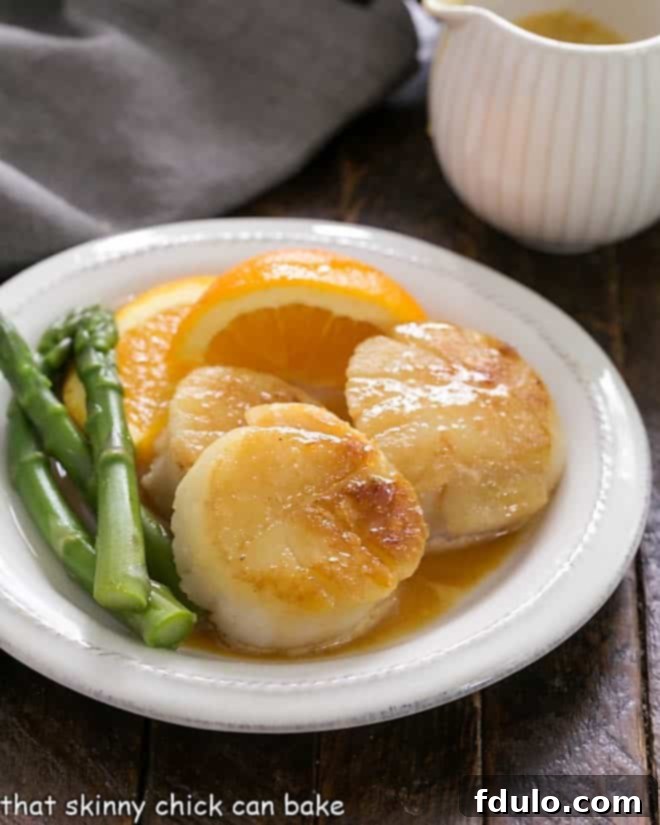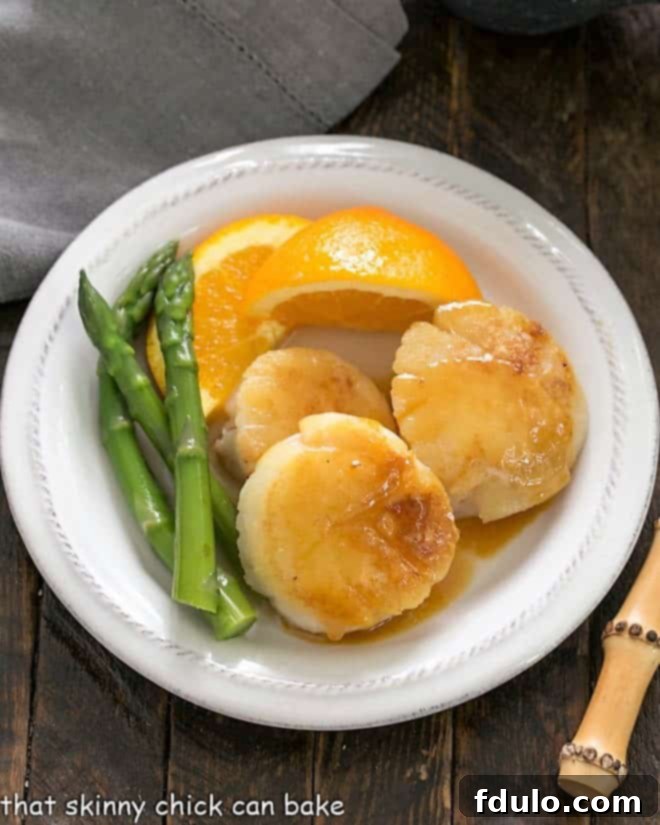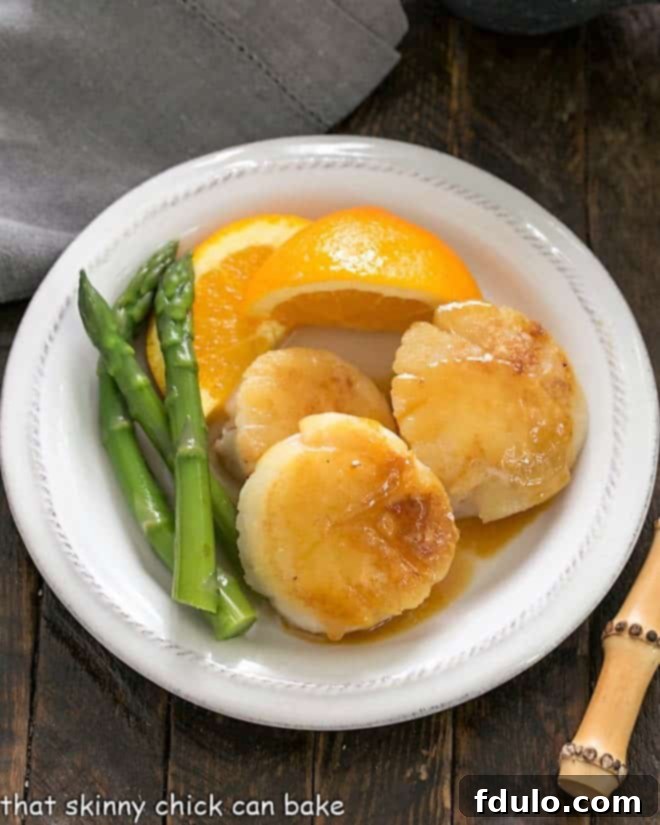Indulge in a truly gourmet dining experience without ever leaving your home kitchen. This exquisite recipe for Pan Seared Scallops with Caramel Orange Sauce transforms fresh, succulent sea scallops into a culinary masterpiece, proving that elegance and simplicity can go hand-in-hand. Prepare to impress your guests, or simply treat yourself to a dish that rivals any fine-dining establishment.
The magic of this dish lies in its beautifully balanced flavors. A sophisticated caramel orange sauce, crafted from simple sugar, freshly squeezed orange juice, and a touch of dry white wine, perfectly accentuates the natural sweetness of premium sea scallops. The result is a harmonious blend of sweet, tangy, and savory notes that dance on your palate. This is more than just a meal; it’s an experience, a restaurant-worthy seared scallops recipe that is surprisingly approachable and incredibly rewarding to make.

Why You Must Master This Pan Seared Scallops Recipe
There are countless reasons to add this exceptional scallop recipe to your culinary repertoire. It’s not just a dish; it’s a testament to the fact that high-end cooking can be accessible and enjoyable for home cooks.
- Expertly Crafted Flavor Profile: This recipe hails from the acclaimed cookbook writer Dorie Greenspan, renowned for her impeccable taste and precise instructions. Her genius shines through in the sweet caramel orange sauce, which perfectly complements and elevates the delicate, sweet succulence of premium sea scallops.
- Impressive Yet Effortless: Imagine dazzling your dinner guests with a dish that looks incredibly sophisticated but is surprisingly simple to prepare. Cooking scallops can seem daunting, but with this easy-to-follow, approachable recipe, you’ll achieve perfect results every time, making it ideal for both special occasions and elevated weeknight meals.
- A Symphony of Textures: The beautiful golden-brown crust achieved through pan-searing contrasts wonderfully with the tender, melt-in-your-mouth interior of the scallops. Paired with the silky-smooth, vibrant orange sauce, each bite is a delightful exploration of textures and flavors.
- Versatility on Your Plate: While undeniably elegant, this dish is versatile. Serve it as a luxurious appetizer for a dinner party or as the star entrée with complementary sides. Its quick cooking time also makes it a fantastic option when you want something special without spending hours in the kitchen.
Essential Tips for Perfect Pan Seared Scallops
Achieving restaurant-quality seared scallops at home requires attention to a few key details. Follow these expert tips to ensure your scallops are perfectly cooked and bursting with flavor.
- Choose the Right Scallops: Always opt for larger sea scallops, not the smaller bay scallops, for searing. Sea scallops have a meatier texture and a larger surface area, which is crucial for developing that beautiful, caramelized crust. For the best quality, look for “dry scallops” which haven’t been soaked in water or preservatives (polyphosphate solutions). Wet scallops absorb water, making them harder to sear and diluting their natural flavor.
- Befriend Your Fishmonger: Building a relationship with a local fishmonger is invaluable. They can offer advice on what seafood is freshest, what’s in season, and can often provide specific recommendations for your recipes. Don’t hesitate to ask questions about the origin and type of scallops available.
- Inspect for Freshness: Fresh scallops should have a sweet, briny smell, reminiscent of the ocean, not a strong “fishy” odor. Their color should be white, creamy, or a pale pink hue. Avoid any scallops that appear grayish, overly translucent, or feel sticky to the touch. These are signs of age or improper handling.
- Prevent Overcooking: The Golden Rule: Overcooking is the most common mistake when preparing scallops. It quickly leads to a rubbery, tough texture that diminishes their natural sweetness. Scallops cook very rapidly in a hot pan. Aim for a quick sear that leaves the center opaque but still tender. If you’re unsure, an instant-read meat thermometer is your best friend. Refer to our frequently asked questions section below for the ideal internal temperature.
- Mastering the Caramel Sauce: The caramel orange sauce is a delicate balance of sweet and tangy. When cooking the sugar, watch it carefully. It will transition from clear to a beautiful amber caramel color quite quickly. Be extremely cautious when adding the liquids (wine and orange juice) to the molten sugar, as the mixture will bubble, sputter, and release hot steam. Stand back, pour slowly, and use a long-handled spoon to stir.

How to Sear Sea Scallops Like a Pro
My husband, Bill, has never quite developed a taste for scallops, which, I must admit, has its perks! It means the entire batch is mine to savor. It’s hard to imagine anyone choosing a peanut butter sandwich over such succulent seafood, but to each their own! This recipe, despite its gourmet appeal, involves just a few simple steps, making it perfect even for a busy weeknight.
- Preparation is Key: Drying the Scallops: The absolute first and most crucial step for a perfect sear is to ensure your scallops are bone-dry. Place them between several layers of paper towels and gently press down to absorb all surface moisture. The drier they are, the better they will brown and form a beautiful crust. Any moisture will steam them instead of searing. Don’t skip this step!
- Crafting the Elegant Caramel Orange Sauce: In a small, heavy-bottomed saucepan, evenly sprinkle the sugar. Place it over medium-high heat. As the sugar begins to melt and turn a golden brown, gently swirl the pan to ensure even caramelization. Once it reaches a deep amber caramel color, carefully and slowly add the white wine and orange juice. The hot sugar will react with the cooler liquid, causing it to bubble and potentially spatter. Stir continuously with a wooden spoon over high heat until the sauce reduces by half, thickening slightly (you should have about ⅓ cup). Remove from heat and set aside, keeping it warm over very low heat while you prepare the scallops.
- Seasoning for Flavor: Just before searing, season the tops of each scallop generously with salt and freshly ground white pepper. While black pepper is acceptable, white pepper blends more seamlessly visually and offers a slightly different, delicate spice.
- The Perfect Sear: High Heat is Your Friend: Heat a heavy skillet (cast iron or stainless steel works best) over high heat until it’s smoking slightly. Add a ½ to 1 tablespoon of olive oil, just enough to coat the bottom of the pan. Once the oil shimmers, carefully place the seasoned scallops in the pan, ensuring they are in a single layer without overcrowding. Cook for approximately 2 minutes per side. You’ll know they’re ready when they develop a beautiful golden-brown crust and their centers change from translucent to opaque. Be vigilant; overcooking will result in a rubbery texture.
- Finishing Touches: Sauce and Serving: Once the scallops are perfectly seared, transfer them immediately to a warm serving plate. Increase the heat under your caramel orange sauce momentarily to ensure it’s hot and fluid. Remove the sauce from the heat and swirl in the cold butter pieces until they are fully melted and incorporated, creating a rich, glossy finish.
- Serve Immediately: Drizzle a generous amount of the warm caramel orange sauce over the seared scallops. Serve them warm, offering any extra sauce at the table for guests to add as they please. Dorie Greenspan wisely recommends enjoying these on the day they’re cooked, as reheating can easily overcook them. However, I’ve found that gently rewarming leftovers yields delicious results for up to 2 days when stored properly in the refrigerator.

Frequently Asked Questions About Scallops
Demystifying scallops helps ensure your cooking experience is successful and enjoyable. Here are some common questions and detailed answers.
What’s the Difference Between Sea Scallops and Bay Scallops?
Bay Scallops are small, typically about half an inch in diameter, and are seasonal, peaking in the fall. They are primarily harvested off the East Coast of the United States. Their meat is light beige to pink, and they are known for their incredibly tender texture and slightly sweeter flavor compared to sea scallops. Bay scallops are best suited for quick cooking methods like poaching, broiling, or a very quick sauté, often used in pasta dishes or seafood stews where a delicate touch is desired.
Sea Scallops are significantly larger, typically 1 to 2 inches in diameter, and come from cold, deep ocean waters, making them available year-round. They possess a sweet, less delicate flavor, a firmer and chewier texture. Their substantial size and robust texture make them ideal for grilling, sautéing, or pan-searing, as they hold up well to higher heat and develop a beautiful crust.
What Should You Look for When Purchasing Scallops?
For the best results, always seek out “dry scallops.” These scallops are sold fresh from the boat, directly from the ocean, and have not been treated with any additives. “Wet scallops,” on the other hand, have been soaked in a tripolyphosphate solution, which causes them to absorb water. While this plumps them up and increases their weight (and thus price), it significantly dilutes their natural flavor and makes it nearly impossible to achieve a good sear due as the excess moisture steams rather than browns them. Look for scallops with a creamy, off-white, or slightly pinkish hue, and a sweet, fresh ocean scent.
How Do You Know When Scallops are Done Cooking?
Pan-seared sea scallops cook very quickly. In a hot pan, they typically require only about 2 minutes per side, for a total cooking time of 3-4 minutes. Visually, a perfectly cooked scallop will have a golden-brown crust on both sides, and its translucent center will have turned opaque. You can always make a small incision into one of the larger scallops to check its doneness. To remove any guesswork, an instant-read thermometer is highly recommended. The internal temperature of scallops should be around 115-120°F (46-49°C) when you remove them from the pan. This accounts for “carry-over cooking,” where the residual heat will continue to cook the scallops, bringing them up to their ideal final temperature of 125-130°F (52-54°C) as they rest. To further facilitate this carry-over cooking, transfer the cooked scallops to a warm serving dish and cover them loosely with foil for 5-10 minutes before serving immediately.
What Are Some Excellent Sides to Serve with Pan Seared Scallops?
The delicate flavor of pan-seared scallops pairs beautifully with a variety of light, fresh sides. Consider serving them alongside steamed or roasted asparagus, which provides a lovely crisp-tender texture. Creamy risotto (especially lemon or mushroom risotto), a light wild rice pilaf, or even a simple green salad with a vinaigrette dressing would also be excellent choices. For a touch of starch, roasted baby potatoes or a smooth parsnip puree can complement the dish without overpowering it.
Can I Prepare Parts of This Recipe Ahead of Time?
Absolutely! The caramel orange sauce can be made a day in advance and stored in an airtight container in the refrigerator. Gently reheat it over low heat just before serving. For the scallops themselves, it’s best to prepare them fresh. However, you can pat them dry and remove the muscle beforehand, keeping them chilled in the refrigerator until you’re ready to sear. This saves a few minutes right before cooking, allowing for a quicker prep time when guests arrive or during a busy weeknight.
Explore More Delicious Seafood Recipes
If you’ve enjoyed these sensational seared scallops, you’ll love exploring other seafood delights:
- Rainbow Salmon Skewers from The View from Great Island – Vibrant and flavorful skewers perfect for grilling.
- Bacon-Wrapped Scallops – A classic appetizer that’s always a crowd-pleaser.
- Grilled Shrimp Scampi – A delightful twist on a beloved pasta dish, made on the grill.
- Grilled Fish Tacos – Light, fresh, and packed with flavor for a casual meal.
- Sea Bass with Tomatoes, Olives, and Capers – An elegant and savory Mediterranean-inspired dish.
- Discover even more Delicious Seafood Recipes to expand your culinary horizons.
Stay in touch through social media @ Instagram, Facebook, and Pinterest. Don’t forget to tag me when you try one of my recipes! And if you love the results, please give it a 5-star rating in the recipe card.

Scallops with Caramel Orange Sauce
10 minutes
7 minutes
17 minutes
4 servings
A quick, elegant way to prepare scallops, perfect for a gourmet meal at home.
Ingredients
- 2 tablespoons of white sugar
- ½ cup of dry white wine
- Juice of 1 large orange – generous ⅓ cup
- 1 pound of sea scallops
- ½ to 1 tablespoon of olive oil
- Salt and freshly ground white pepper, for taste
- 1 tablespoon cold butter, cut into 3 pieces
Instructions
- Sprinkle the sugar into a small saucepan. Place the pan over medium-high heat and warm the sugar until it starts to melt.
- As soon as you see it turn brown, begin to gently swirl the pan. When the sugar has turned a deep caramel color, carefully add the white wine and orange juice. It may bubble and spatter, so watch out.
- Turn the heat up to high, stir with a wooden spoon, and boil the sauce until it is reduced by half (about ⅓ cup). Remove the pan from heat and set it aside.
- Pat the scallops dry between two paper towels. Slice or pull off the little muscle attached to the sides of the scallops. Have a warm serving platter and a small strainer at the ready.
- Put the saucepan with the caramel sauce over very low heat so that it can warm while you cook the scallops.
- Heat a heavy skillet on high. When the pan is hot, pour in 1½ teaspoons olive oil and swirl to coat the bottom.
- Add the scallops, and season them with salt and pepper.
- Cook for about 2 minutes per side, or until the scallops are firm on the outside and opaque in the center.
- Transfer the scallops to the serving platter.
- Finish the sauce by removing the pan from the heat and adding the butter pieces. Swirl the pan until the butter is melted.
- Season the sauce with salt and pepper, then pour through the strainer into a pitcher. Drizzle some of the sauce over the scallops and pass the rest at the table.
Notes
Recipe from Around My French Table by Dorie Greenspan.
Make sure to look for the larger sea scallops, not bay scallops.
If you’d like to use a thermometer to monitor doneness, pull the scallops out of the pan when they reach about 115-120°F (46-49°C). There will be some carry-over cooking that will bring them up another 10°.
Nutrition Information:
Yield:
4
Serving Size:
1
Amount Per Serving:
Calories: 286
Total Fat: 7g
Saturated Fat: 3g
Trans Fat: 0g
Unsaturated Fat: 4g
Cholesterol: 54mg
Sodium: 963mg
Carbohydrates: 27g
Fiber: 1g
Sugar: 18g
Protein: 24g
Thatskinnychickcanbake.com occasionally offers nutritional information for recipes contained on this site. This information is provided as a courtesy and is an estimate only. This information comes from online calculators. Although thatskinnychickcanbake.com attempts to provide accurate nutritional information, these figures are only estimates. Varying factors such as product types or brands purchased can change the nutritional information in any given recipe. Also, many recipes on thatskinnychickcanbake.com recommend toppings, which may or may not be listed as optional and nutritional information for these added toppings is not listed. Other factors may change the nutritional information such as when the salt amount is listed “to taste,” it is not calculated into the recipe as the amount will vary. Also, different online calculators can provide different results. To obtain the most accurate representation of the nutritional information in any given recipe, you should calculate the nutritional information with the actual ingredients used in your recipe. You are solely responsible for ensuring that any nutritional information obtained is accurate.
HOW MUCH DID YOU LOVE THIS RECIPE?
Please leave a comment on the blog or share a photo on Pinterest
